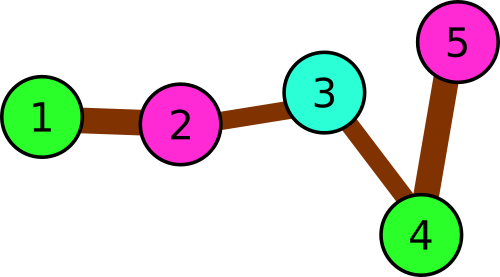codeforces 781A Andryusha and Colored Balloons(樹上dfs)
Andryusha goes through a park each day. The squares and paths between them look boring to Andryusha, so he decided to decorate them.
The park consists of n squares connected with (n - 1) bidirectional paths in such a way that any square is reachable from any other using these paths. Andryusha decided to hang a colored balloon at each of the squares. The baloons' colors are described by positive integers, starting from 1
Andryusha wants to use as little different colors as possible. Help him to choose the colors!
InputThe first line contains single integer n (3 ≤ n ≤ 2·105) — the number of squares in the park.
Each of the next (n - 1) lines contains two integers x and y (1 ≤ x, y ≤ n) — the indices of two squares directly connected by a path.
It is guaranteed that any square is reachable from any other using the paths.
OutputIn the first line print single integer k — the minimum number of colors Andryusha has to use.
In the second line print n integers, the i-th of them should be equal to the balloon color on the i-th square. Each of these numbers should be within range from 1 to k.
Examples input3 2 3 1 3output
3 1 3 2input
5 2 3 5 3 4 3 1 3output
5 1 3 2 5 4input
5 2 1 3 2 4 3 5 4output
3 1 2 3 1 2Note
In the first sample the park consists of three squares: 1 → 3 → 2. Thus, the balloon colors have to be distinct.
 Illustration
for the first sample.
Illustration
for the first sample.In the second example there are following triples of consequently connected squares:
- 1 → 3 → 2
- 1 → 3 → 4
- 1 → 3 → 5
- 2 → 3 → 4
- 2 → 3 → 5
- 4 → 3 → 5
 Illustration
for the second sample.
Illustration
for the second sample.In the third example there are following triples:
- 1 → 2 → 3
- 2 → 3 → 4
- 3 → 4 → 5
 Illustration
for the third sample.
Illustration
for the third sample.#include <cstdio>
#include <cstring>
#include <algorithm>
using namespace std;
const int maxn = 2e5+10;
struct node
{
int to,next;
}edge[2*maxn];
int head[2*maxn],ans,n,cnt,a[maxn];
void add(int u,int v)
{
edge[cnt].to=v;
edge[cnt].next=head[u];
head[u]=cnt++;
}
void dfs(int x,int y)
{
int num=1,i;
for(i=head[x];i!=-1;i=edge[i].next)
{
if(edge[i].to!=y)
{
while(num==a[x]||num==a[y])
num++;
a[edge[i].to]=num++;
ans=max(ans,num-1);
dfs(edge[i].to,x);
}
}
}
int main()
{
int u,v;
while(scanf("%d",&n)!=EOF)
{
memset(head,-1,sizeof(head));
cnt=0;
for(int i=1;i<n;++i)
{
scanf("%d%d",&u,&v);
add(u,v);
add(v,u);
}
memset(a,0,sizeof(a));
a[1]=1;
ans=0;
dfs(1,-1);
printf("%d\n",ans);
printf("%d",a[1]);
for(int i=2;i<=n;++i)
printf(" %d",a[i]);
printf("\n");
}
return 0;
} 